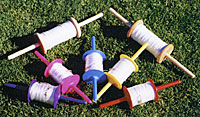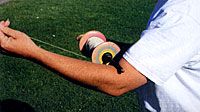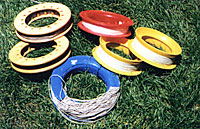How to Use a Kite Winder
Winders and How they Work

Called the India Spool, e-z winder, spinner and other names, made from bamboo, plastic or wood, the common feature is the handle through the middle and caps to keep line from spilling off. This most common kite string winder is a very fast tool if someone demonstrates the winder-trick.
The first step is to get the kite down:
- Walk towards the kite pulling the line down hand-over-hand. Be careful not to pile all your line in one place.
- Keep moving around leaving the line in little piles until the kite is in your hand.
- With someone to help, one person can retrieve the kite while the other winds the line. A larkshead knot on the end of the line makes good sense for easy on-off.
Once the kite is on the ground:

- Hold one end of the winder in your right hand with the other end in the crook of your left elbow. (Lefties will be reversed)
- Run the string through your left-hand fingers. Spin the winder with your right hand while guiding the string back-and-forth with your left hand.
- Practice this technique a couple of times. Remember to keep a bit of drag on the line when spinning so it won’t be too loose.
The Best Way to use Hoop Winders

Hoop winders are usually made of plastic and shaped like a doughnut. The kite string wraps around the hoop.
If you bring your kite out of the sky while you wind your line, you have to pull against the wind, increasing the tension on the line and possibly crushing the hoop
There is a better way. Remember that retrieving the kite and winding the line should be two separate jobs. Mark one side of the hoop. Maybe your name or the line strength.
When flying a kite, lay the hoop on the ground with the writing side up. Let line uncoil from the hoop into your hand and so into the sky.
When done, retrieve the kite by pulling in the line hand-over-hand, being careful not to pile it all in one place.
After the kite is down and put away, pick up the hoop and hold it with the writing side out and wind the loose line back on around the hoop. Note the connection between anti-clockwise unwinding off the hoop and clockwise winding on the same side of the hoop helps keep the line from twisting.
